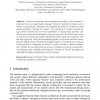Free Online Productivity Tools
i2Speak
i2Symbol
i2OCR
iTex2Img
iWeb2Print
iWeb2Shot
i2Type
iPdf2Split
iPdf2Merge
i2Bopomofo
i2Arabic
i2Style
i2Image
i2PDF
iLatex2Rtf
Sci2ools
107
Voted
IFIP
2009
Springer
2009
Springer
On Designing for Tussle: Future Internet in Retrospect
Abstract. Over the past decades, the fundamental principles of the Internet architecture have not significantly changed. However, Internet evolution and its effects on participants’ interests have triggered the need for re-defining these design principles. “Design for Tussle” is an aspiration for future network designs, which enables the involved stakeholders to express their possibly conflicting socio-economic preferences on service instances. We performed a series of case studies examining whether established technologies are compatible with this new approach. Using the knowledge gained, we provide canonical examples and help protocol and network designers better to consider how to come up to the problem of “designing for tussle” in order to realize a flexible architecture. Finally, we associate protocol success to adoption and show, using empirical evidences, that carefully embracing the “Design for Tussle” paradigm can outweigh the higher complexity in protocol design...
| Added | 26 May 2010 |
| Updated | 26 May 2010 |
| Type | Conference |
| Year | 2009 |
| Where | IFIP |
| Authors | Costas Kalogiros, Alexandros Kostopoulos, Alan Ford |
Comments (0)

